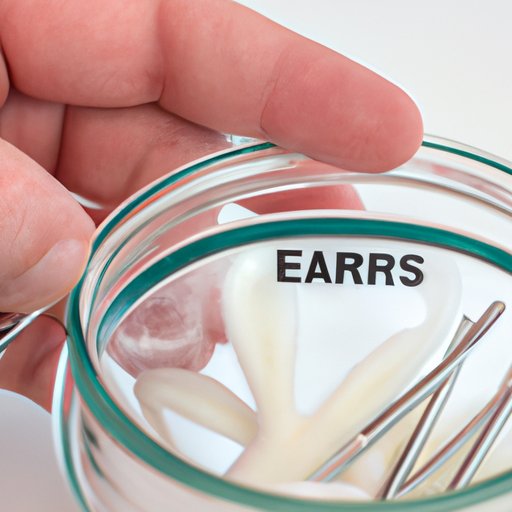
Introduction
Ear hygiene is an essential part of overall health and wellbeing. Unfortunately, many people overlook proper ear care, leading to the accumulation of ear wax and other ear problems. Ear wax, when not removed adequately, can cause discomfort, impaired hearing, and even infections. In this article, we will provide a comprehensive guide on how to clean wax out of ears safely and effectively.
Step-by-Step Guide
Before diving into the actual cleaning, it’s essential to gather the necessary tools, including cotton balls, earwax removal drops, a bulb syringe, and a clean towel. The following are the techniques for safe and effective ear cleaning:
- Drops: Before removing ear wax, soften it first by putting a few earwax removal drops in the affected ear. Tilt your head to one side to let the drops seep deep into the ear canal. Wait for a few minutes for the wax to get soft and then wipe away the excess wax.
- Bulb Syringe: This tool functions by using water to flush out the wax. Tilt your head and gently pour warm water into the ear. Use the bulb syringe to squirt warm water in gentle bursts. Use the towel to dry off any drops from your ear
- Cotton Swabs: Using cotton swabs can be dangerous as it can push the wax deeper into the ear. It’s better to use them on the outer ear to remove excess wax.
To maintain healthy ears, it’s good to clean them regularly. However, be careful not to over-clean them. Daily cleaning can remove the natural and essential oils that keep your ears healthy.
Home Remedies
Many people prefer to use natural remedies to clean their ears instead of synthetic treatments. Here are some home remedies for removing ear wax safely:
- Warm Water: Warm water is typically enough to flush out some ear wax build-up. Flush warm clean water out of a bulb syringe, or put your head under the showerhead running lukewarm water.
- Vinegar: Mix equal parts of white vinegar and warm water. Use a syringe to put a few drops of this solution into the affected ear, and wait for a few minutes before flushing with lukewarm water. This remedy is especially useful for people who suffer from recurring ear infections or swimmer’s ear.
- Olive Oil: Put a few drops of warm olive oil in your ear for up to three days. Then flush it out with lukewarm water or use a bulb syringe. Olive oil softens the wax buildup, making it easier to remove.
However, it’s essential to take precautions when using home remedies for ear wax removal. They can be harmful if used incorrectly or excessively. Don’t use home remedies on ears with tubes, ruptured eardrums, or other ear conditions without consulting with a medical professional.
The Dangers of Overcleaning
While regular ear cleaning is essential, overdoing it could lead to health complications. Here are some risks associated with extreme ear cleaning:
- Ear Infections: Frequent ear cleaning can cause tiny abrasions in your ear canal, making it easier for bacteria to enter and cause an infection.
- Hearing Loss: Removing ear wax excessively can cause the damage of essential ear mechanisms to cause hearing loss.
- Tinnitus: Tinnitus is an annoying constant ringing sound. Overcleaning your ears can cause tinnitus, as the ear cleaning process can irritate the eardrum.
It is best to clean your ears once a week to keep them clean and healthy. If you feel any pain or discomfort, stop the process immediately and seek medical attention from a professional healthcare provider.
Myth-Busting
There are lots of myths surrounding ear cleaning. Here are the facts:
- Cotton swabs: Cotton swabs aren’t suitable for cleaning your ears, as they may push the wax deeper into the ear canal and cause an infection. They can also cause damage to the eardrum.
- Ear candles: Ear candles are not suitable for ear cleaning, as they can spontaneously combust and cause burns. They do not remove wax and can push the wax further into the ear canal.
- Hairpins and other foreign items: Inserting any foreign object into your ear is not safe and can cause serious ear damage or infection.
It’s essential to differentiate between earwax and an infection. If you experience swelling, fever, or severe pain, you should seek immediate medical attention.
When to See a Doctor
If you’re experiencing health complications associated with ear wax buildup, it’s best to seek professional medical help. Here are some signs that indicate the need for medical attention:
- Significant or sudden hearing loss or pain
- Foul-smelling discharge coming out of your ear
- Continuous or severe tinnitus or ear ringing
- Injuries to your ear, such as cuts or burns
When seeing a healthcare provider for ear cleaning, choose a licensed professional with the correct qualifications to avoid complications. They may use ear irrigation or other specialized tools to remove ear wax safely and efficiently.
Conclusion
Cleaning your ears safely and effectively can significantly improve your overall health. Regular cleaning can prevent health complications such as infections and hearing loss. However, you should take care to avoid over-cleaning and using incorrect methods. We hope that this guide has provided you with all the information you need to maintain clean and healthy ears. Remember, if you experience any discomfort or health issues, seek medical attention immediately.





